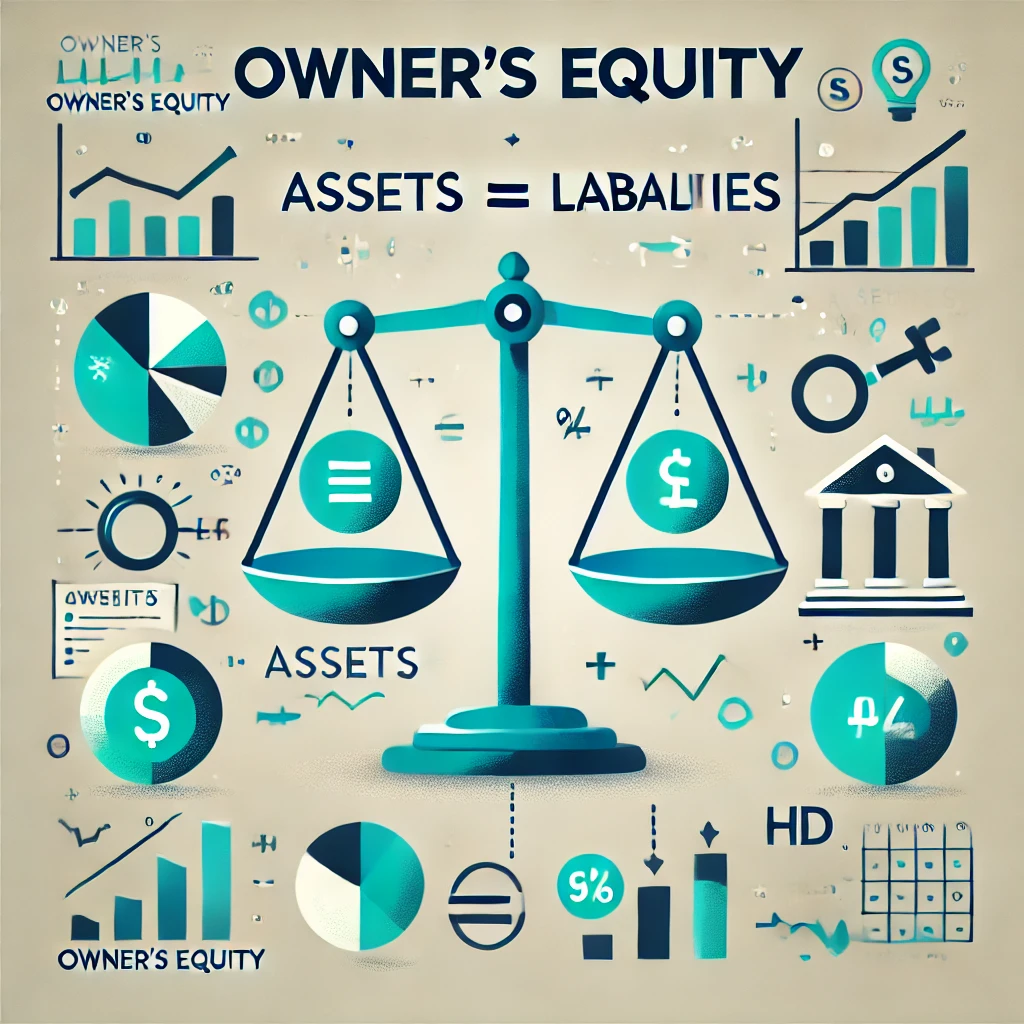Owner’s equity is a key concept in accounting that refers to the ownership value in an asset or business after all liabilities (debts) are subtracted. It represents the difference between the total assets and total liabilities of a business. Understanding owner’s equity helps businesses track their financial health and is essential for decision-making.
This concept is often used to evaluate a company’s financial standing and growth potential and calculate the return on investments. The owner’s equity may increase through business profits, new investments by the owner, or the retention of earnings. On the other hand, it may decrease due to losses, withdrawals by the owner, or debt payments.
What is Owner’s Equity?
Owner’s equity, also known as shareholder’s equity or net assets, represents the residual value of a company’s assets after all liabilities are paid off. It is calculated by subtracting total liabilities from total assets. This equity reflects the amount owners or shareholders would theoretically receive if all assets were liquidated and all debts repaid. It is a crucial component of a firm’s balance sheet, indicating the financial health and capital structure.
What Does Owners Equity include?
Owner’s equity includes all of the value that an owner holds in a business after subtracting liabilities from assets. The components of owner’s equity vary depending on the business structure, but they generally include the following:
- Capital Contributions: Money or assets that the owner initially invests into the business.
- Retained Earnings: Profits earned by the business are not distributed as dividends but are kept to fund further growth or pay off debts.
- Withdrawals or Drawings: Funds taken by the owner from the business, reducing the owner’s equity.
- Net Income or Loss: The difference between the business’s total income and total expenses. A net income increases the owner’s equity, while a net loss decreases it.
In a sole proprietorship or partnership, owner’s equity is usually presented as a single amount, summarizing the total capital, retained earnings, and any additional investments. In corporations, owner’s equity is typically broken down into stockholders’ equity, consisting of common stock, retained earnings, and additional paid-in capital.

How to Calculate Owner’s Equity
To calculate owner’s equity, we subtract the business’s total liabilities from its total assets. This formula is simple but powerful, helping to determine the financial strength of a business.
Owner’s Equity = Total Assets – Total Liabilities
This equation gives a clear picture of the value of a business that belongs to its owners. Here’s a simple example of how to calculate it:
- Total Assets: $300,000 (Value of everything the business owns, such as cash, inventory, buildings, equipment)
- Total Liabilities: $150,000 (Debts or obligations, such as loans, accounts payable, and credit lines)
In this case, the owner’s equity would be:
Owner’s Equity = $300,000 (Total Assets) – $150,000 (Total Liabilities) = $150,000
This means that the business owner has $150,000 worth of equity in the business. Calculating owner’s equity is an essential step in evaluating the financial health of a business. It helps the business owner or potential investors understand how much of the company’s value is attributable to the owner’s contributions.
Statement of Owner’s Equity
A Statement of Owner’s Equity is a financial statement that shows changes in the owner’s equity during a specific period. This statement typically includes the beginning balance of the owner’s equity, additions (such as capital contributions or retained earnings), and subtractions (such as withdrawals or losses). It is a part of the financial reporting process and helps business owners understand how equity in their business evolves.
The Statement of Owner’s Equity begins with the opening balance of the owner’s equity. Then, it lists any additional investments or profits earned, followed by any withdrawals or losses. It concludes by showing the closing balance of the owner’s equity for the period.
An example of what this statement might look like for a business is:
| Statement of Owner’s Equity | Amount |
|---|---|
| Opening Balance | $100,000 |
| Add: Net Income | $20,000 |
| Less: Drawings | -$5,000 |
| Ending Balance | $115,000 |
Statement of Owner’s Equity helps in assessing the ability of the business to generate profits and the owner’s share in the business. It also serves as a tool for future business planning, as it shows how the business is managing its capital and how much the owner will retain if the business were to liquidate.
Owner’s Equity Examples
Let’s look at some examples of owner’s equity to get a clearer understanding of how it works in real-world business situations.
Example 1: Sole Proprietorship
Let’s assume a small business, “ABC Bookstore,” owned by Alex. At the start of the year, Alex invested $40,000 of his own money into the business. During the year, the bookstore made a profit of $20,000, and Alex withdrew $5,000 to cover personal expenses.
- Starting Investment: $40,000
- Net Profit: $20,000
- Withdrawals: -$5,000
- Owner’s Equity: $40,000 + $20,000 – $5,000 = $55,000
In this case, Alex’s owner’s equity in the bookstore is $55,000.
Example 2: Corporation
For a corporation, the calculation of owner’s equity is slightly more complex as it is divided into different components. Let’s say a company, “TechCo,” has the following:
- Total Assets: $500,000
- Total Liabilities: $300,000
- Retained Earnings: $50,000
- Common Stock Issued: $100,000
TechCo’s owner’s equity is calculated as:
Owner’s Equity = Total Assets – Total Liabilities = $500,000 – $300,000 = $200,000
This owner’s equity is divided among the stockholders as follows:
- Retained Earnings: $50,000
- Common Stock: $100,000
- Additional Paid-In Capital: $50,000
So, the total owner’s equity for the company is $200,000, but it’s broken down into different types of equity.
Difference between Owners Equity and Business Fair Value
It is essential to distinguish between owner’s equity and business fair value, as these two terms are often confused. While both represent the value of a business, they are different in terms of how they are calculated and what they represent.
- Owner’s Equity: Represents the ownership stake of the business owner after all debts have been paid. It is calculated by subtracting total liabilities from total assets.
- Business Fair Value: Refers to the current market value of a business or its assets, determined by what a buyer would be willing to pay for the business in an open market. It is more influenced by external factors like market conditions, the reputation of the business, and future earning potential.
The key difference is that owner’s equity reflects what the owner is entitled to if the business were sold and all debts were paid off, while fair value reflects how much the business is worth on the open market, which could be higher or lower than owner’s equity, depending on various market factors.
Owners Equity FAQs
What is the formula to calculate owner’s equity?
Owner’s equity is calculated by subtracting total liabilities from total assets. The formula is:
Owner’s Equity = Total Assets – Total Liabilities
How does net income affect owner’s equity?
Net income increases owner’s equity. It represents the profits earned by the business, which add to the owner’s share. If a business earns a profit, this amount gets added to owner’s equity.
Can withdrawals decrease owner’s equity?
Yes, withdrawals by the owner reduce owner’s equity. When an owner takes money out of the business for personal use, it decreases the total value of equity in the business.
What is the difference between owner’s equity and business fair value?
Owner’s equity is the value remaining after liabilities are subtracted from assets, whereas business fair value is the price a buyer would pay for the business in the market, often reflecting external market conditions.
Why is owner’s equity important for a business?
Owner’s equity shows the financial health of a business and helps business owners make informed decisions. It provides insight into the profitability, solvency, and long-term viability of the business.


